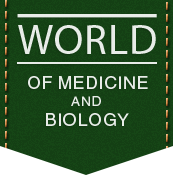| About the author: |
O. M. Grabovyi, T. S. Mervinsky, S. І. Savosko, L. M. Yaremenko |
| Heading |
EXPERIMENTAL MEDICINE |
| Type of article |
Scentific article |
| Annotation |
In the case of a stroke, a glial scar forms around the affected area. According to the hypothesis, scar formation occurs not only by glial cells but also mesenchymal cells, which should be reflected in the cellular composition and extracellular matrix. The aim of this study was to investigate changes in collagen and proteoglycans content in the glial scar in the brain after hemorrhagic stroke and under conditions of modulation of compensatory-repair processes. A local hemorrhagic stroke was modeled in rats, and histochemical methods were used to study changes in collagen and proteoglycans content in the scar formation areas. An increase in collagen accumulation was observed on days 3, 10, and 30 after the stroke, with a tendency to decrease by day 60. The elimination of the hemorrhage was characterized by the accumulation of macrophages with PAS-positive cytoplasm and an increase in proteoglycans content around the hemorrhage. This indicates the involvement of mesenchymal-derived cellular elements in scar formation. In conditions of granulocyte-colony stimulating factor application, collagen accumulation was significantly lower, as it was with dexamethasone treatment, while isolated dexamethasone action led to scar formation characterized by an increase in collagen and macrophage content. |
| Tags |
hemorrhagic stroke,glial scar,collagen,proteoglycans,dexamethasone,granulocyte colony-stimulating factor |
| Bibliography |
- Ayazi M, Zivkovic S, Hammel G, Stefanovic B, Ren Y. Fibrotic Scar in CNS Injuries: From the Cellular Origins of Fibroblasts to the Molecular Processes of Fibrotic Scar Formation. Cells. 2022;11(15):2371. doi: 10.3390/cells11152371.
- Cai H, Ma Y, Jiang L, Mu Z, Jiang Z, Chen X, et al. Hypoxia response element-regulated MMP-9 promotes neurological recovery via glial scar degradation and angiogenesis in delayed stroke. Mol Ther. 2017;25(6):1448-1459. doi: 10.1016/j.ymthe.2017.03.020.
- Graboviy OM, Mervinsky TS, Savosko SI, Yaremenko LM. Dynamics of changes in the representation of mesenchymal cells in the forming glial scar during dexamethasone application. Reports of Morphology. 2024;30(3):25-32. doi: 10.31393/morphology-journal-2024-30(3)-03.
- Hara M, Kobayakawa K, Ohkawa Y, Kumamaru H, Yokota K, Saito T, et al. Interaction of reactive astrocytes with type I collagen induces astrocytic scar formation through the integrin–N-cadherin pathway after spinal cord injury. Nat Med. 2017;23:818-828. doi: 10.1038/nm.4354.
- Huang L, Wu ZB, ZhuGe Q, Zheng W, Shao B, Wang B, Sun F, Jin K. Glial scar formation occurs in the human brain after ischemic stroke. International Journal of Medical Sciences. 2014;11(4):344-348. doi: 10.7150/ijms.8140.
- Kawauchi S, Kono A, Muramatsu Y, Hennes G, Seki S, Tominaga S, et al. Meningeal Damage and Interface Astroglial Scarring in the Rat Brain Exposed to a Laser-Induced Shock Wave(s). J Neurotrauma. 2024;41(15-16):e2039-e2053. doi: 10.1089/neu.2023.0572.
- Kjell J, Götz M. Filling the Gaps - a call for comprehensive analysis of extracellular matrix of the glial scar in region- and injury-specific contexts. Front Cell Neurosci. 2020;14:32. doi: 10.3389/fncel.2020.00032.
- Kang L, Yu H, Yang X, Zhu Y, Bai X, Wang R, et al. Neutrophil extracellular traps released by neutrophils impair revascularization and vascular remodeling after stroke. Nat Commun. 2020;11(1):2488. doi: 10.1038/s41467-020-16191-y.
- Lee SR, Kim HY, Rogowska J, et al. Involvement of matrix metalloproteinase in neuroblast cell migration from the subventricular zone after stroke. J Neurosci. 2006;26(13):3491-3495. doi: 10.1523/JNEUROSCI.4085-05.2006.
- Li Y, Chen J, Quan X, Chen Y, Han Y, Chen J, et al. Extracellular Vesicles Maintain Blood-Brain Barrier Integrity by the Suppression of Caveolin-1/CD147/VEGFR2/MMP Pathway After Ischemic Stroke. Int J Nanomedicine. 2024;19:1451-1467. doi: 10.2147/IJN.S444009.
- Liu J, Zhu YM, Guo Y, Lin L, Wang ZX, Gu F, et al. Inhibition of GSK3β and RIP1K attenuates glial scar formation induced by ischemic stroke via reduction of inflammatory cytokine production. Front Pharmacol. 2020;11:812. doi: 10.3389/fphar.2020.00812.
- Marangon D, Castro E Silva JH, Cerrato V, Boda E, Lecca D. Oligodendrocyte progenitors in glial scar: a bet on remyelination. Cells. 2024;13(12):1024. doi: 10.3390/cells13121024.
- Moeendarbary E, Weber I, Sheridan G, Koser D, Soleman S, Haenzi B, et al. The soft mechanical signature of glial scars in the central nervous system. Nat Commun. 2017;8:14787. doi: 10.1038/ncomms14787.
- Tewari BP, Chaunsali L, Prim CE, Sontheimer H. A glial perspective on the extracellular matrix and perineuronal net remodeling in the central nervous system. Front Cell Neurosci. 2022;16:1022754. doi: 10.3389/fncel.2022.1022754.
- Zheng J, Wu H, Wang X, Zhang G, Lu J, Xu W, et al. Temporal dynamics of microglia-astrocyte interaction in neuroprotective glial scar formation after intracerebral hemorrhage. J Pharm Anal. 2023;13(8):862-879. doi: 10.1016/j.jpha.2023.02.007.
|
| Publication of the article |
«World of Medicine and Biology» №2(92), 2025 year, 159-164 pages, index UDK 576.32/.36:577.175.5:[616.831-005.1-085:615.212]-092 |
| DOI |
10.26724/2079-8334-2025-2-92-159-164 |
